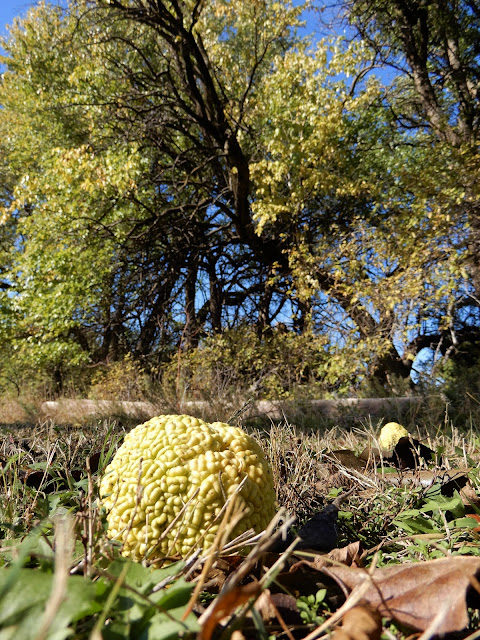 |
| Hedge posts and hedge apples - a farm still life |
They look a little like brains - maybe a leftover from Halloween celebrations.
But my brain does not compute the price some people are willing to pay for these "treasures" found scattered for free along our country roads.
"Six Fresh Picked Homegrown Organic Hedge Apples, Osage Orange, 6 count." Only $17.95.
Oh, well, they are ORGANIC. It must make them extra valuable. I found a "bargain basement" price at another site:
Fresh Picked Homegrown Organic Hedge Apples, Osage Orange, Approximately 12-15, only $21.00.
 |
| Hedge apples strategically placed on a pile of hedge posts. |
Move over wheat crop! I think I have discovered a new cash crop. Agriculture today is always looking for that market to expand beyond producing wheat, corn and soybeans. Hedge apples just may be my niche market. I'm seeing a cash crop lying along the ditches on country roads these days. Others still hang from the branches of the osage orange trees where they grow.
Hedge apples remind me of my Grandpa Leonard, who believed they repelled boxelder bugs. He would gather them in the fall and place them outside the house to keep the "Byers bugs" away. (People in my neck of the woods called boxelder bugs "Byers bugs" because they were the orange and black of the Byers Hornets, where I went to school through 4th grade.)So, do Grandpa's claims have scientific validity? Of course, I turned to Google, the ultimate source for every modern researcher, right?
And that's when I discovered that I could have my own get-rich scheme. I was driving by a cash crop and didn't even know it. There are actually people selling these little yellow-green balls that remind me of brains.
From another website:
 |
Each
Hedgeapple comes with its own individual container to prevent damage
to carpet and wood surfaces. Hedgeapple with container is shown at
left. It is recommended to place a hedgeapple in each room or adjacent closet.
Average weight 1 LB. / Hedgeapple
Average
repellant life in an air-condition environment is 3 months.
Hedgeapples can be sliced in half to expedite their effects, although
life is greatly reduced.
Now all that's left is finding those handy dandy containers, and I am set.
Or maybe not.
Here's what I learned in a Iowa State University Extension brochure:
The use of the hedge apples for insect control is one of the most enduring pest management home remedies. Placement of hedge apples around the foundation or inside the basement is claimed to provide relief from cockroaches, spiders, boxelder bugs, crickets and other pests.
The use of hedge apples as a pest solution is communicated as a folk tale complete with testimonials about apparent success. However, there is an absence of scientific research and therefore no valid evidence to confirm the claims of effectiveness. Although insect deterrent compounds have been extracted from hedge apples in laboratory studies, these do not provide a logical explanation about why hedge apples would work as claimed. At this time, there is nothing to recommend the use of hedge apples for pest control.
The Salina Journal had a Kids Page devoted to hedge apples earlier this month. It was written by Mike Szydlowski, a science coordinator for Columbia (OH) Public Schools, for the USA Today Network.
The article said hedge apples' history goes back tens of thousands of years. Even though they aren't eaten by animals today, the hedge apples used to be delicious food for the giant mastodons and wooly mammoths that once roamed North America.
Native Americans found the tree extremely useful. While they did not eat the fruit, the wood was prized for making high-quality bows. The Osage people would travel great distances to find this wood, and they gave the tree the name Osage orange.
Later on, the trees were planted one foot apart, creating hedges to keep livestock in place. The branches had small thorns on them and, when planted close, it made a good barrier. This is where the name “hedge apple” came from. This practice lasted a long time until barbed wire was invented in the 1870s.
The Osage orange trees themselves do provide a valuable resource on the
County Line and elsewhere on the Plains. They make great fence posts.
Whether the hedge apples work as boxelder repellents or not, seeing them
scattered along the roadside was a great reminder of my Grandpa
Leonard. And that's priceless.
So what do you think? Do hedge apples repel bugs?
Whether they do or not, my friend, Okema, found a new use for them. She decorated tables at a recent luncheon with hedge apples and Pyracantha branches.
 |
| Photo & arrangement by Okema Shaw |
Who knew they could look so good!?








My Aunt Ina was really into crafts. She used to pay me a nickel each for each "perfect" hedge apple I would collect for her. She turned them into really pretty arrangements, etc. and sold the results at craft fairs. I'm sure she would be delighted to know they are still desirable (or maybe desirable again?). I think I got rooked on the nickel each part, though LOL!
ReplyDeleteThat made me laugh! Yes, you definitely should have negotiated a better labor arrangement.
DeleteI got a kick out of Byers Bugs. I had an unnamed aunt (now deceased) who called box elder bugs "Democrats." Oh. My. ;-)
ReplyDeleteLocation, location, location - as they say. I'm sure her moniker would not be politically correct these days. (What is?)
DeleteI've never seen nor heard of a hedge apple. What interesting information you have found.
ReplyDeleteThanks Helen!
Delete